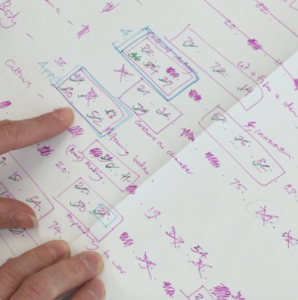Reconstructing Ghosts
September 14th, 2022Originally posted: 11 April 2017
We have been incredibly fortunate to be able to harness the creative talent from our students here at Birmingham City University.
One team of second and third year students have been working on the exhibition and have been briefed to reproduce a number of garments from Birmingham School of Art Dress Archive and the Kate Elizabeth Bunce Collection to represent the ‘ghosts’ of past dress worn and collected in both of these collections. Students have collaborated across Fashion Design with Design for Performance pathway, Fashion Design with Garment Technology, and Theatre, Performance and Events.
It has been a privilege to listen to the students’ conversations whilst visually unpicking the garments, their analysis has instinctively explored Jules David Prown’s material culture analysis and it has required them to be, as Mida and Alexander write in their book, dress detectives.
They have studied garments from the mid Regency through to the late Victorian period and have reproduced them using, as I called it, ‘guerrilla costume making techniques.’ I asked that they forget all they know about contemporary pattern cutting and that they rely on their eyes, tacit knowledge and their creative instincts. There have been questions between them about why things were cut and constructed in these seemingly peculiar methods. We are about to see their toiles (prototypes) and it’s exciting as it is the result of their thinking, visual unpicking and creative skill evidenced in their toiles.
We have, as part of the process, used Janet Arnold’s books, ‘Patterns of Fashion: 1 & 2′ as a way to reassure the students of the unfamiliar shapes they are being exposed to.
As part of the exhibition, we will be using their patterns, samples and technical drawings to evidence the process of their guerrilla costume craft. Some have kept reflective journals of the process and the inittiative has been rich for both participant and academic.
Next we begin the process of constructing the final pieces, we are excited to see their ‘Ghosts’…
Louise Chapman
Rich Pickings
September 14th, 2022Originally posted: 11 April 2017
I was hoping mine would be the first blog post, but Anne (conference chair) seems to have beaten me to it… I’ve been involved in the conference planning from the outset – largely as a reviewer and, at times, a shoulder to cry on – but, perhaps inevitably, it has all seemed A LONG WAY OFF until Anne and I sat down to schedule the paper presentations. This herculean task was tackled by first sorting papers into the broad categories authors were required to select as key words. Within these largely disciplinary bandings, we began to match up papers with others that would complement them, either because they explored similar themes, or because it seemed as if they might enter into a fruitful dialogue.

Planning the paper sessions
Here, the richness of the material we were working with became apparent. We found we were able to discern themes that spanned the initial conference themes and – while some presentations are grouped according to academic discipline (jewellery, art history, material culture, etc) – frequently, we constructed groupings that are genuinely multidisciplinary. Inside Out: The actor’s experience (session one; track two) presents perspectives from cultural theory (Arnold), costume design (Hrga) and performance art (Kargol); In Jewellery at the Boundary (session one; track three), material culture takes centre stage, but is explored through the lens of literary analysis in Astfalck’s talk, through that of geography in Al-Ismaili’s talk about settled Bedouin communities in Oman, and through Colley’s creative practice as a maker of adornments.
This thematic approach allowed us to collate the meanings that the authors had found woven into the clothes that we wear and which structure our lives, both tying us to our cultural roots and allowing us to imagine futures that are quite different. Many of the papers explore historical moments: Between the Wars (session three; track two) considers the trajectory of tweed (Burks), the jewellery of Nancy Cunard (Bliss) and the costume balls of American socialites (McHugh); others consider the behaviours that particular dress inspires, such as the three papers on Fashion Consumption (session three; track three). Making is a prominent theme (Craft Making – session three; track one – has some fascinating content!), as is remaking. Moments in time: ghosts of the past and imaginary futures (session one; track three) features a number of reflections on what happens when clothes are altered or re-made (including the background to the Bunce collection, housed at Birmingham City University (Chapman), and also prominent in the Cabinets of Costume exhibition at the Parkside Gallery). Finally, the making of knowledge – through research – also finds a voice ( Methodologies – session five; track one).
It certainly feels real, now! But, I tell you what – I can’t wait. The different strands that run through the conference papers point to the pervasive influence of dress and costume throughout society, and the rich range of fields represented hint at lively conversations to come.
Sian Hindle
Welcome to our blog
September 14th, 2022Originally posted: 9 April 2017
A conference always seems so much more real when the programme is done. We’ve just published the draft and it’s very exciting to see our hard work of the last few months come to fruition. For all of us on the conference committee, it really has been a testing time. We first began discussing the conference a year ago; it seemed such a long time then, but it’s flown by. For the exhibition curators especially, there has been so much to achieve in what actually is a relatively short time – not only reviewing and curating the submissions from our contributors, but selecting exhibits from our own archive, as well as designing and managing the exhibition itself. They will be talking about this in a future blog.
We are lucky in having some very talented students, who have provided some great creative input to the conference. I’m sure delegates will be impressed with their design work, but what has impressed us most is the professionalism with which they have approached the briefs we gave them – and all while doing their own final projects. Again, more about them in the future.
In many ways, the most tasking aspect has been the review process. We received around ninety submissions, and simply collating, reviewing and responding to those has proved quite daunting. We decided early on to use an online conference management tool. There are quite a few to choose from; we opted for the one that seems to be the most popular – Easychair: renamed Nightmare Chair by the committee. Yanyan Wang has taken most of the responsibility for this, with some help from me, and it has been an uphill struggle. When we first set up an account, back when we put out the Call for Submissions, I spent a whole weekend trying to get to grips with it. In desperation, and feeling really inadequate, I googled problems with Easychair – only to find dozens of sites discussing the same issues. We have somehow managed to make it work, though as many of you know, it has let us down from time to time, and at every stage, there have been a new set of problems to overcome. I’m thinking of writing a blog post of hints and tips for those thinking of organising a conference in the future. My first tip will be – don’t use Easychair.
Anne Boultwood

